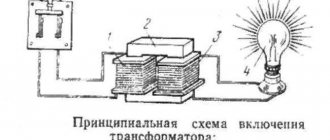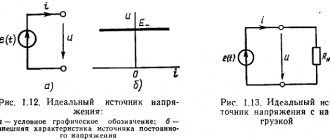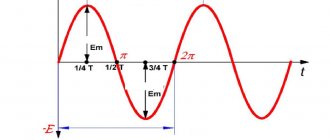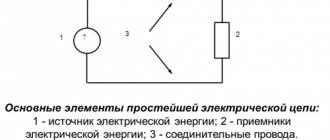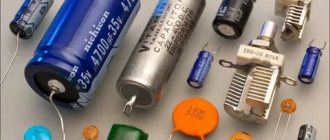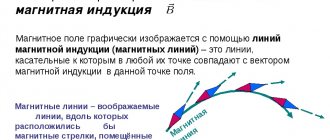Electricity - directed (ordered) movement of particles, electric charge carriers, in an electromagnetic field.
What is electric current in different substances? Let us take, accordingly, moving particles:
- in metals - electrons,
- in electrolytes - ions (cations and anions),
- in gases - ions and electrons,
- in a vacuum under certain conditions - electrons,
- in semiconductors - holes (electron-hole conductivity).
Sometimes electric current is also called displacement current, which arises as a result of a change in the electric field over time.
Electric current manifests itself as follows:
- heats conductors (the phenomenon is not observed in superconductors);
- changes the chemical composition of the conductor (this phenomenon is primarily characteristic of electrolytes);
- creates a magnetic field (manifests itself in all conductors without exception).
Classification
Direct and alternating current
If charged particles move inside macroscopic bodies relative to a particular medium, then such a current is called electric “conduction current”. If macroscopic charged bodies (for example, charged raindrops) are moving, then this current is called “convection”.
Currents are divided into direct and alternating. There are also all kinds of alternating current. When defining types of current, the word “electric” is omitted.
- Direct current is a current whose direction and magnitude do not change over time. There can be a pulsating, for example a rectified variable, which is unidirectional.
- Alternating current is an electric current that varies over time. Alternating current refers to any current that is not direct.
- Periodic current is an electric current, the instantaneous values of which are repeated at regular intervals in an unchanged sequence.
- Sinusoidal current is a periodic electric current that is a sinusoidal function of time. Among alternating currents, the main one is the current whose value varies according to a sinusoidal law. Any periodic non-sinusoidal current can be represented as a combination of sinusoidal harmonic components (harmonics) having corresponding amplitudes, frequencies and initial phases. In this case, the electrostatic potential of each end of the conductor changes in relation to the potential of the other end of the conductor alternately from positive to negative and vice versa, passing through all intermediate potentials (including zero potential). As a result, a current arises that continuously changes direction: when moving in one direction, it increases, reaching a maximum, called the amplitude value, then decreases, at some point becomes equal to zero, then increases again, but in a different direction and also reaches the maximum value , decreases and then passes through zero again, after which the cycle of all changes resumes.
- Quasi-stationary current is a relatively slowly varying alternating current, for instantaneous values of which the laws of direct currents are satisfied with sufficient accuracy. These laws are Ohm's law, Kirchhoff's rules and others. Quasi-stationary current, like direct current, has the same current strength in all sections of an unbranched circuit. When calculating quasi-stationary current circuits due to the emerging e. d.s. inductions of capacitance and inductance are taken into account as lumped parameters. Ordinary industrial currents are quasi-stationary, except for currents in long-distance transmission lines, in which the condition of quasi-stationary along the line is not satisfied.
- High-frequency current is an alternating current (starting from a frequency of approximately tens of kHz), for which such phenomena become significant that are either useful, determining its use, or harmful, against which the necessary measures are taken, such as radiation of electromagnetic waves and skin effect . In addition, if the wavelength of alternating current radiation becomes comparable to the dimensions of the elements of the electrical circuit, then the quasi-stationary condition is violated, which requires special approaches to the calculation and design of such circuits.
- A pulsating current is a periodic electric current, the average value of which over a period is different from zero.
- Unidirectional current is an electric current that does not change its direction.
Eddy currents
Eddy currents Foucault
Eddy currents (or Foucault currents) are closed electric currents in a massive conductor that arise when the magnetic flux penetrating it changes, therefore eddy currents are induced currents. The faster the magnetic flux changes, the stronger the eddy currents. Eddy currents do not flow along specific paths in wires, but when they close in the conductor, they form vortex-like circuits.
The existence of eddy currents leads to the skin effect, that is, to the fact that alternating electric current and magnetic flux propagate mainly in the surface layer of the conductor. Heating of conductors by eddy currents leads to energy losses, especially in the cores of AC coils. To reduce energy losses due to eddy currents, they use the division of alternating current magnetic circuits into separate plates, isolated from each other and located perpendicular to the direction of the eddy currents, which limits the possible contours of their paths and greatly reduces the magnitude of these currents. At very high frequencies, instead of ferromagnets, magnetodielectrics are used for magnetic circuits, in which, due to the very high resistance, eddy currents practically do not arise.
Direct Current: Reviving an Old Technology
Solar Smart Grid in Haiti
Today, 86 years after Edison's death, there are signs that the great inventor was not as wrong about direct current as people once believed. Edison's ideas are becoming relevant again as a number of recent developments make direct current more attractive.
Previously, electricity was produced by alternating current in generators of large coal or nuclear power plants, as well as in hydro turbines. They distribute energy through the AC network. Transformers allow voltage to be increased to several hundred thousand volts by holding current in cables. But now a number of electricity suppliers are moving towards using DC. These include, for example, solar power plants, which are usually supported by batteries or electrochemical storage systems. Converting DC to AC inevitably involves losses, making the DC grid the best choice for these suppliers.
Characteristics
Historically, it was accepted that the “direction of current” coincides with the direction of movement of positive charges in the conductor. Moreover, if the only current carriers are negatively charged particles (for example, electrons in a metal), then the direction of the current is opposite to the direction of movement of the charged particles.
Drift speed of electrons
The drift speed of the directional movement of particles in conductors caused by an external field depends on the material of the conductor, the mass and charge of the particles, the surrounding temperature, the applied potential difference and is much less than the speed of light. In 1 second, electrons in a conductor move due to ordered motion by less than 0.1 mm. Despite this, the speed of propagation of the electric current itself is equal to the speed of light (the speed of propagation of the electromagnetic wave front). That is, the place where the electrons change the speed of their movement after a change in voltage moves with the speed of propagation of electromagnetic oscillations.
Current strength and density
Electric current
Electric current has quantitative characteristics: scalar - current strength, and vector - current density.
Current strength a is a physical quantity equal to the ratio of the amount of charge
, which has passed for some time
through the cross section of the conductor, to the value of this period of time.
Current strength in SI is measured in amperes (international and Russian designation: A).
According to Ohm's law, the current strength
in a section of the circuit is directly proportional to the electrical voltage
, applied to this section of the circuit, and is inversely proportional to its resistance
.
If the electric current in a section of the circuit is not constant, then the voltage and current are constantly changing, while for ordinary alternating current the average values of voltage and current are zero. However, the average power of heat released in this case is not equal to zero.
Therefore, the following concepts are used:
- instantaneous voltage and current, that is, acting at a given moment in time.
- amplitude voltage and current, that is, maximum absolute values
- effective (effective) voltage and current are determined by the thermal effect of the current, that is, they have the same values that they have for direct current with the same thermal effect.
Current density is a vector, the absolute value of which is equal to the ratio of the strength of the current flowing through a certain section of the conductor, perpendicular to the direction of the current, to the area of this section, and the direction of the vector coincides with the direction of movement of the positive charges forming the current.
According to Ohm's law in differential form, the current density in the medium
proportional to the electric field strength
and medium conductivity
.
Power
When there is current in a conductor, work is done against resistance forces. The electrical resistance of any conductor consists of two components:
- active resistance - resistance to heat generation;
- reactance - resistance caused by the transfer of energy to an electric or magnetic field (and vice versa).
Typically, most of the work done by an electric current is released as heat. The heat loss power is a value equal to the amount of heat released per unit time. According to the Joule-Lenz law, the power of heat loss in a conductor is proportional to the strength of the flowing current and the applied voltage:
Power is measured in watts.
In a continuous medium, volumetric loss power
is determined by the scalar product of the current density vector
and electric field strength vector
at this point:
Volumetric power is measured in watts per cubic meter.
Radiation resistance is caused by the formation of electromagnetic waves around a conductor. This resistance is complexly dependent on the shape and size of the conductor, and on the length of the emitted wave. For a single straight conductor, in which everywhere the current is of the same direction and strength, and the length L of which is significantly less than the length of the electromagnetic wave emitted by it
, the dependence of resistance on wavelength and conductor is relatively simple:
The most commonly used electric current with a standard frequency of 50 Hz corresponds to a wave length of about 6 thousand kilometers, which is why the radiation power is usually negligible compared to the power of thermal losses. However, as the frequency of the current increases, the length of the emitted wave decreases, and the radiation power increases accordingly. A conductor capable of emitting noticeable energy is called an antenna.
Frequency
The concept of frequency refers to an alternating current that periodically changes strength and/or direction. This also includes the most commonly used current, which varies according to a sinusoidal law.
The AC period is the shortest period of time (expressed in seconds) through which changes in current (and voltage) repeat. The number of periods performed by current per unit time is called frequency. Frequency is measured in hertz, one hertz (Hz) equals one cycle per second.
Bias current
Sometimes, for convenience, the concept of displacement current is introduced. In Maxwell's equations, the displacement current is present on equal terms with the current caused by the movement of charges. The intensity of the magnetic field depends on the total electric current, equal to the sum of the conduction current and the displacement current. By definition, the bias current density
is a vector quantity proportional to the rate of change of the electric field
in time:
The fact is that when the electric field changes, as well as when current flows, a magnetic field is generated, which makes these two processes similar to each other. In addition, a change in the electric field is usually accompanied by a transfer of energy. For example, when charging and discharging a capacitor, despite the fact that there is no movement of charged particles between its plates, they speak of a displacement current flowing through it, transferring some energy and closing the electrical circuit in a unique way. Bias current
in a capacitor is determined by the formula:
,
Where
- charge on the capacitor plates,
- electrical voltage between the plates,
- electrical capacitance of the capacitor.
Displacement current is not an electric current because it is not associated with the movement of an electric charge.
Regulated Sources
The regulated source consists of the following components:
- a step-down transformer;
- rectifier;
- smoothing filter (eliminates ripples);
- DC voltage stabilizer.
DC voltage stabilizer is an integrated circuit that maintains the output voltage at the same level, regardless of its fluctuations at the input.
Fluctuations caused by voltage changes in the electrical network, changes in load current or temperature. Blocks with such stabilizers are called adjustable.
Switching power supplies are common today; they consist of the following components:
- input rectifier;
- inverter;
- step-down high-frequency transformer;
- output rectifier.
The inverter turns the pre-rectified current back into alternating current, but at the same time significantly increases its frequency - up to 10-15 kHz. At this frequency, the dimensions of the transformer and losses in it are significantly reduced. The inverter consists of key transistors controlled by a microcircuit.
The same principle is implemented in welding inverters, which explains their compactness.
There are many stabilizer microcircuits with different properties. For example, the LM317 chip is designed for a current of up to 1.5 A and allows you to adjust the output voltage. A more powerful stabilizer is the LM350 chip.
Main types of conductors
Unlike dielectrics, conductors contain free carriers of uncompensated charges, which, under the influence of a force, usually an electrical potential difference, move and create an electric current. The current-voltage characteristic (the dependence of current on voltage) is the most important characteristic of a conductor. For metal conductors and electrolytes, it has the simplest form: the current strength is directly proportional to the voltage (Ohm's law).
Metals - here the current carriers are conduction electrons, which are usually considered as an electron gas that clearly exhibits the quantum properties of a degenerate gas.
Plasma is an ionized gas. Electric charge is transferred by ions (positive and negative) and free electrons, which are formed under the influence of radiation (ultraviolet, x-ray and others) and (or) heating.
Electrolytes are liquid or solid substances and systems in which ions are present in any noticeable concentration, causing the passage of electric current. Ions are formed through the process of electrolytic dissociation. When heated, the resistance of electrolytes decreases due to an increase in the number of molecules decomposed into ions. As a result of the passage of current through the electrolyte, ions approach the electrodes and are neutralized, settling on them. Faraday's laws of electrolysis determine the mass of a substance released on the electrodes.
There is also an electric current of electrons in a vacuum, which is used in electron beam devices.
Current source operation
By moving electric charges along a section of a circuit, electric current does work. It consists of the work of Coulomb forces and the work of external forces:
A = Shark + Astor.
The work of a source is the work of external forces to transfer electrical charges along a conductor over time:
Stork = Astor = ε * I * t,
Where:
- ε – emf (V);
- I – current (A);
- t – time (s).
The work of electric current determines the degree of conversion of electricity into its other forms.
Electric currents in nature
Lightning
Atmospheric electricity is electricity that is contained in the air. Benjamin Franklin was the first to show the presence of electricity in the air and explain the cause of thunder and lightning.
It was subsequently found that electricity accumulates in the condensation of vapors in the upper atmosphere, and the following laws were indicated that atmospheric electricity follows:
- in a clear sky, as well as in a cloudy sky, the electricity of the atmosphere is always positive, unless it rains, hails or snows at some distance from the observation site;
- the voltage of cloud electricity becomes strong enough to be released from the environment only when cloud vapors condense into raindrops, evidence of which can be seen in the fact that lightning discharges do not occur without rain, snow or hail at the observation site, excluding a return lightning strike;
- atmospheric electricity increases as humidity increases and reaches a maximum when rain, hail and snow fall;
- the place where it rains is a reservoir of positive electricity, surrounded by a belt of negative, which in turn is enclosed in a belt of positive. At the boundaries of these belts the stress is zero.
The movement of ions under the influence of electric field forces forms a vertical conduction current in the atmosphere with an average density equal to about (2÷3) 10−12 A/m².
The total current flowing over the entire surface of the Earth is approximately 1800 A.
Lightning is a natural sparking electrical discharge. The electrical nature of the auroras was established. St. Elmo's Fire is a natural corona electrical discharge.
Biocurrents - the movement of ions and electrons plays a very significant role in all life processes. The biopotential created in this way exists both at the intracellular level and in individual parts of the body and organs. The transmission of nerve impulses occurs using electrochemical signals. Some animals (electric stingrays, electric eels) are capable of accumulating potentials of several hundred volts and use this for self-defense.
Dependence of voltage ripple on capacitor capacitance
Let's take a practical look at why we need to install a large capacitor. In the photo below we have three capacitors of different capacities:
Let's look at the first one. We measure its nominal value using our LC meter. Its capacity is 25.5 nanoFarads or 0.025 microFarads.
We connect it to the diode bridge according to the diagram above
And we cling to the oscilloscope:
Let's look at the oscillogram:
As you can see, the pulsations still remain.
Well, let's take a capacitor with a larger capacity.
We get 0.226 microfarads.
We connect it to the diode bridge in the same way as the first capacitor and take readings from it.
And here is the actual oscillogram
Not... almost, but still not the same. The pulsations are still visible.
Let's take our third capacitor. Its capacity is 330 microfarads. Even my LC meter cannot measure it, since my limit on it is 200 microfarads.
We hook it to the diode bridge and take an oscillogram from it.
And here she actually is
Here you go. It's a completely different matter!
So, let's draw some conclusions:
- the larger the capacitance of the capacitor at the output of the circuit, the better. But don’t overuse the capacity! Since in this case our device will be very large, because capacitors of large capacities are usually very large. And the initial charge current will be huge, which can lead to an overload of the supply circuit.
— the lower the resistance the load at the output of such a power supply is, the greater the ripple amplitude will appear. They combat this with the help of passive filters, and also use integrated voltage stabilizers, which produce the purest DC voltage.
Application
When studying electric current, many of its properties were discovered, which made it possible to find practical application in various areas of human activity, and even to create new areas that would have been impossible without the existence of electric current. After practical application was found for electric current, and for the reason that electric current can be obtained in various ways, a new concept arose in the industrial sphere - electric power.
Electric current is used as a carrier of signals of varying complexity and types in different areas (telephone, radio, control panel, door lock button, and so on).
In some cases, unwanted electrical currents appear, such as stray currents or short circuit currents.
Use of electric current as an energy carrier
- obtaining mechanical energy in all kinds of electric motors,
- obtaining thermal energy in heating devices, electric furnaces, during electric welding,
- obtaining light energy in lighting and signaling devices,
- excitation of electromagnetic oscillations of high frequency, ultrahigh frequency and radio waves,
- receiving sound,
- obtaining various substances by electrolysis, charging electric batteries. Here electromagnetic energy is converted into chemical energy,
- creating a magnetic field (in electromagnets).
Use of electric current in medicine
Electrophoresis
- diagnostics - the biocurrents of healthy and diseased organs are different, and it is possible to determine the disease, its causes and prescribe treatment. The branch of physiology that studies electrical phenomena in the body is called electrophysiology. Electroencephalography is a method for studying the functional state of the brain.
- Electrocardiography is a technique for recording and studying electric fields during heart activity.
- Electrogastrography is a method for studying the motor activity of the stomach.
- Electromyography is a method for studying bioelectric potentials arising in skeletal muscles.
Power supplies
To power this or that equipment, it is necessary to use special means - direct current sources. These devices, also called power supplies, are found in almost any electronic device, from televisions to phone chargers.
Such sources can be classified as follows:
- Galvanic elements. These are familiar batteries that work using a chemical reaction that occurs inside the battery.
- Generators. Devices that convert mechanical energy into electrical energy using electromagnetic induction.
- Rectifiers. The most used devices in consumer electronic equipment. They convert alternating current from the outlet to direct current.
This classification can be divided into other subcategories, more specific and universal. The choice of power source is based on the type of operation of the device where it will be used.
electrical safety
Warning on electrical safety
Includes legal, socio-economic, organizational and technical, sanitary and hygienic, treatment and preventive, rehabilitation and other measures. Electrical safety rules are regulated by legal and technical documents, regulatory and technical framework. Knowledge of the basics of electrical safety is mandatory for personnel servicing electrical installations and electrical equipment. The human body is a conductor of electric current. Human resistance with dry and intact skin ranges from 3 to 100 kOhm.
A current passed through a human or animal body produces the following effects:
- thermal (burns, heating and damage to blood vessels);
- electrolytic (decomposition of blood, disruption of physical and chemical composition);
- biological (irritation and excitation of body tissues, convulsions)
- mechanical (rupture of blood vessels under the influence of steam pressure obtained by heating by the blood flow)
The main factor determining the outcome of electric shock is the amount of current passing through the human body. According to safety precautions, electric current is classified as follows:
- “safe” is considered to be a current whose long-term passage through the human body does not cause harm to it and does not cause any sensations; its value does not exceed 50 μA (alternating current 50 Hz) and 100 μA direct current;
- The “minimum perceptible” alternating current for humans is about 0.6–1.5 mA (alternating current 50 Hz) and 5–7 mA for direct current;
- threshold “non-releasing” is the minimum current of such strength that a person is no longer able to tear his hands away from the current-carrying part by force of will. For alternating current this is about 10-15 mA, for direct current - 50-80 mA;
- The “fibrillation threshold” is an alternating current (50 Hz) strength of about 100 mA and a direct current of 300 mA, the impact of which for more than 0.5 s is likely to cause fibrillation of the heart muscles. This threshold is also considered conditionally fatal for humans.
In Russia, in accordance with the Rules for the technical operation of electrical installations of consumers (Order of the Ministry of Energy of the Russian Federation dated January 13, 2003 No. 6 “On approval of the Rules for the technical operation of electrical installations of consumers”) and the Rules for labor protection during the operation of electrical installations (Order of the Ministry of Energy of the Russian Federation dated December 27, 2000 N 163 “On approval of Interindustry Rules on Labor Protection (Safety Rules) for the Operation of Electrical Installations"), 5 qualification groups for electrical safety were established depending on the qualifications and experience of the employee and the voltage of electrical installations.
Voltage, Current and Resistance
Electricity passing through a wire or other conductor is characterized by voltage U, current I and resistance R. Voltage is potential energy. Current represents the flow of electrons in a conductor, and resistance represents the force of its friction.
A good way to think of direct electric current is as an analogy to water flowing through a hose. Voltage is the potential that builds up at one end of a wire due to an excess of negatively charged electrons. This is similar to increased water pressure in a hose. The potential causes electrons to move through the wire into a region of positive charge. This potential energy is called voltage and is measured in volts.
Direct electric current is the flow of electrons, measured in amperes. It is similar to the speed of water moving through a hose.
Ohm is a unit of measurement of electrical resistance. The atoms of the conductor are arranged so that electrons will pass through with little friction. In insulators or poor conductors, atoms offer strong resistance or prevent the movement of charged particles. This is similar to the friction of water in a hose as it passes through it.
Thus, voltage is similar to pressure, flow is similar to current, and hydraulic resistance is similar to electrical resistance.
Calculation of U, I, R
The DC electrical voltage with known current and resistance can be found using the formula U = I × R. For example, if I = 0.2 A and R = 1000 Ohm, then U = 0.2 A * 1000 Ohm = 200 V.
If the voltage and resistance are known, the current can be calculated using the equation I = V / R. For example, if U = 110 V and R = 22000 ohms, then I = 110 V / 22000 ohms = 0.005 A.
If the voltage and current are known, then R = V / I. If V = 220 V and I = 5 A, then R = 220 V / 5 A = 44 Ohms.
Thus, Ohm's law shows the relationship between voltage, current and resistance in a simple electrical circuit. It can be applied to both DC and AC circuits.
Applications
Domestic and commercial buildings
This character can be represented by the Unicode character U+2393 (⎓) found on many electronic devices that require or produce direct current.
DC is commonly found in many ultra-low voltage applications and some low voltage applications, especially if they are battery powered or solar powered systems (since both can only produce DC).
Most electronic circuits require a constant current power source.
Residential DC installations usually have different types of sockets, connectors, switches, and fixtures from those suitable for AC. This is mainly due to lower voltages, which results in higher currents to produce the same amount of power. power.
In general, when working with DC electrical appliances, it is important to observe polarity, unless the device has a diode bridge to correct this.
The EMerge Alliance is an open industry association that develops standards for DC power distribution in hybrid homes and commercial buildings.
Automotive industry
Most automotive applications use DC current. An automobile battery provides power to start the engine, lights, and ignition system. A generator is an alternating current device that uses a rectifier to produce direct current to charge batteries. Most passenger cars on the highway nominally use a 12 system. Many heavy trucks, farm equipment or earthmoving equipment with Diesel engines use 24V systems. Some older vehicles used 6V, such as the original classic Volkswagen Beetle. At one point, a 42V electrical system was considered for automobiles, but found little use. To save weight and save wire, the car's metal frame is often connected to one pole of the battery and used as the return conductor in the circuit. Often the negative pole is the chassis ground, but the positive pole may be used in some wheeled or marine vehicles.
Telecommunications
Telephone exchange for communications equipment uses a standard –48 V power supply. Negative polarity is achieved by grounding the positive terminal of the power system and the battery bank. This is done to prevent electrolysis deposits. Telephone installations use a battery system to maintain power to subscriber lines during power outages.
Other devices can be powered from the DC telecommunications system using a DC to DC converter to provide any convenient voltage.
Many phones connect to twisted pair wires and use a splice tee to internally separate the AC voltage between the two wires (the beep) from the DC voltage between the two wires (used to power the phone).
High voltage power transmission
Main article: High voltage direct current
High voltage direct current (HVDC) power transmission systems use direct current for the primary transmission of electrical power, as opposed to the more common alternating current systems. For long distance transmission, HVDC systems can be less expensive and have lower electrical losses.
Another
Fuel cell applications (mixing hydrogen and oxygen together with a catalyst to produce electricity and water as by-products) also only produce DC current.
Light aircraft electrical systems are typically 12V or 24V DC, similar to those found in automobiles.
Serial and parallel connection
In an electrical circuit, multiple devices, such as light bulbs, may be connected in a single line between the positive and negative terminals of a battery. This connection is called serial. One problem with this arrangement is that if one bulb burns out, it acts as a switch and turns off the entire circuit.
Receivers can also be connected in parallel, so that if any lamp goes out, the circuit will not be de-energized. The parallel connection circuit is used not only in Christmas tree garlands - electrical wiring in houses is also carried out in parallel. Therefore, lighting and appliances can be turned on and off independently of each other.
Natural electricity
If we start from afar, it is obvious that electrical discharges occur in nature.
The first thing that comes to mind is a thunderstorm - lightning. This is due to the fact that it can be seen, it poses a threat, and people are taught from childhood how to behave in a thunderstorm. Brief physics of a thunderstorm - the presence of a potential difference between the ground and a cloud, or between clouds. Moreover, the fact that the essence of lightning is an electric discharge, and not the wrath of the gods, was said only in the 18th century by Benjamin Franklin. Lightning is not the prerogative of planet Earth - they are also found on other planets, which means this phenomenon is all-encompassing, on a universal scale.
Centuries before Franklin, a man known as Thales generated electricity between an amber stick and wool. Then, however, he did not understand that these were electrons, since they were discovered later. He simply saw that after friction, small objects were attracted to the stick. The same ebonite stick whose name made you laugh in physics lessons at school. Perhaps he believed that this is the essence of the phenomenon of magnetism, and not electricity.
Electricity is also found in living things. For example, fish: electric rays, eels, African catfish. The voltage in these individuals can reach up to 600 volts, and the current strength can exceed tens of amperes. Fishes with electric location (beaked whales) are also known. Lightning does not seem to escape from terrestrial creatures, except perhaps the cartoon Pikachu.
And of course atoms - nucleus, protons, electrons, neutrons. Protons are positively charged particles, electrons are negatively charged. The ordered movement of electrons is a current. But no current flows because the number of protons is balanced by the number of electrons. If this equality is violated, then the substance has a charge. Also electricity. All these brain impulses, muscle contractions, and static electricity in the end.
All of the above is certainly interesting, but has little practical application. We won’t force stingrays to hit light bulbs so we can have light.
Story
Further information: History of Electricity Transmission
Brush Electric Company's central power plant with dynamos producing direct current to power arc lamps for public lighting in New York City. It began work in December 1880 at 133 West Twenty-Fifth Street. The high voltage at which it operated allowed it to power a circuit 2 miles (3.2 km) long.[4]
Direct current was produced in 1800 by an Italian physicist. Alessandro Voltabattery, his Galvanic Pile.[5] The nature of how current flows was not yet understood. French physicist André-Marie Ampere proposed that current flows in one direction from positive to negative.[6] When French tool maker Hippolyte Pixius built the first dynamo-electric generator in 1832, he discovered that when the magnet used was passed through loops of wire every half turn, it caused the electric current to reverse, creating alternating current.[7] At Ampere's suggestion, Pixii later added a commutator, a type of "switch" in which contacts on a shaft work together with "brush" contacts to create a constant current.
In the late 1870s and early 1880s, electricity began to be generated at the power plant. They were originally configured to power arc lighting (a popular type of street lighting), operating on very high voltage direct or alternating current (usually above 3000 volts).[8] This was followed by widespread adoption of low-voltage direct current for indoor electric lighting in offices and homes. Thomas Edison released his electric incandescent utility lamp in 1882. Because of the significant advantages of alternating current over direct current when using transformers to step up and step down voltages to enable much longer transmission distances, direct current was replaced by alternating current in the power delivery system over the next few decades. In the mid-1950s. High voltage direct current transmission has been developed and is now an option in place of long distance high voltage alternating current systems. For long distance submarine cables (e.g. between countries such as NorNed), this DC option is the only technically feasible option. For applications requiring constant current, such as third rail in power systems, the alternating current is distributed to a substation, which uses a rectifier to convert the power to direct current.

